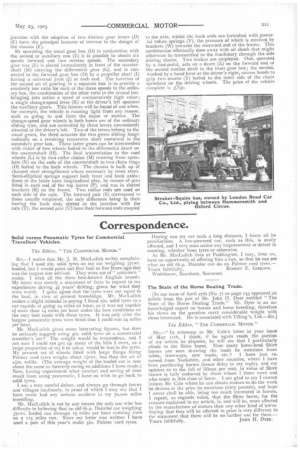Correspondence.
Page 9

If you've noticed an error in this article please click here to report it so we can fix it.
Solid versus Pneumatic Tyres for Commercial Travellers' Vehicles.
The Editor, "THE COMMERCIAL MOTOR."
Sir,-1 notice that Mr. J. M. MacLulich writes complaining that I used 210. solid tyres on my car weighing 37cwt. loaded, but I would point out that four or five pears ago this was the largest size advised. They were not of" unknown " make. I tried all the three best-known English brands. My letter was merely a statement of facts in regard to my experiences during 4 years' driving, given for what they were worth. I quite agree that the tyres were not equal to the load, in view of present knowledge. Mr. MacLulich makes a slight mistake in saying I fitted zin. solid tyres to a car capable of going 24 miles an hour, as it was not capable of more than 14 mites per hour under the best conditions on the very best roads with these tyres. It was only after the largest pneumatic tyres were fitted that I could run 24 miles per hour.
Mr. MacLulich gives some interesting figures, but does he seriously suggest using 51n. solid tyres on a commercial traveller's car? The weight would be tremendous, and I am sure I could not get up many of the hills I meet, as a large proportion of my 6 to ioh.p. would be lost in the tyres. My present set of wheels fitted with large flange fixing Palmer cord tyres weighs about licwe less than the set of 2iin. solids. (The average weight of the loaded car is now about the same as formerly owing to additions I have made.) Now, having experienced what comfort and saving of time result from using pneumatic, I have no wish to go back to solid tyres.
I am a very careful driver, and always go through towns and villages cautiously, in proof of which I may say that I have never had any serious accident in my 7o,o(x) miles travelling.
Mr. MacLulich is not by any means the only one who has difficulty in believing that an old 6h.p. Daimler car weighing 3'7cwt. loaded can average 19 miles per hour running time on a ii miles run. Since my letter was written I have used a pair of this year's make sin. Palmer cord tyres. Having run my car such a long distance, I know all its peculiarities. A low-powered car, such as this, is easily affected, and I very soon notice any improvement or defect in running, whether from tyres or otherwise. As Mr. MacLulich lives at Paddington, I may, iater on, have an opportunity of offering him a run, so that he can see what an old 6h.p. Daimler can do on Palmer cord tyres.— 'fours faithfully, ROBERT E. GIBBONS. Wodehousc, Burnham, Somerset.
The State of the Horse Dealing Trade.
I In our issue of April 27th (No. 7) on page 143 appeared an article from the pen of Mr. John H. Dyer entitled "The State of the Horse Dealing Trade." Mr. Dyer is an acknowledged expert on horses and horse breeding, therefore his views on the question carry considerable weight with those interested. He is associated with Tilling's, Ltd.—ED.] The Editor, "THE COMMERCIAL MOTOR."
Sir,—" In reference to Mr. Cole's letter in your issue of May i ith, I think, if he again reads the portion of my article he disputes, he will see that I particularly allude to the Shire horse. How many home-bred Shire horses are seen drawing the loads he mentions from tubes, tramways, new roads, etc.? I have just returned from Yorkshire, and other counties, where I have been purchasing horses (hence delay in my reply), and my opinion as to the fall of fifteen per cent. In value of Shire horses is fully endorsed by those whom I 'there meet and who trade in this class of horse. I am glad to say I cannot inform Mr. Cole where he can obtain motors to do the work he desires at the price he mentions (sixty pounds), and hope I never shall be able, being too much interested in horses. I repeat, as regards value, that the Shire horse, for the reasons explained in my article, is, and will be, more affected by the manufacture of motors than any other kind of horse. Saying that they will be affected in price is very different to the statement that there will be no further use for them.— Yours faithfully, JOHN H. DYER.
















